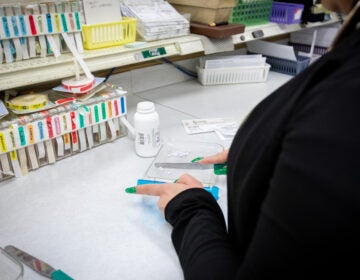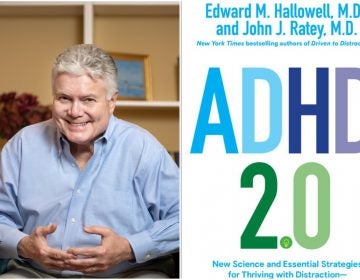How mental health apps revealed problems in diagnosing ADHD
Getting an ADHD diagnosis and treatment from online platforms like Cerebral and Done seemed to increase demand for the stimulant Adderall - but that’s just part of the problem
This story is from The Pulse, a weekly health and science podcast.
Find it on Apple Podcasts, Spotify, or wherever you get your podcasts.
Many people with attention-deficit/hyperactivity disorder had their lives derailed last fall.
In mid-October, the Food and Drug Administration announced a shortage of Adderall, a common stimulant used to treat ADHD. Adderall is comprised of amphetamine and dextroamphetamine, two central nervous stimulants that improve focus and increase dopamine in the brain. But for those who use Adderall, know that the blue or sometimes orange pill is what helps them stay employed, finish schoolwork on time, or even fold a week-old pile of laundry.
The FDA said the shortage was due to manufacturing delays, low supply, and increased demand. Because Adderall is a controlled substance, the Drug Enforcement Agency only clears a certain amount of the medication to be sold in the United States annually.
Not long after this announcement, many people began to fixate on one of the reasons that contributed: The increase in demand. In 2021, 41.4 million Adderall prescriptions were given out in the U.S., up more than 10 percent from the previous year. And millions of people that were directly affected wondered why the number of Adderall prescriptions exploded.
Meghan Codispoti spent nine months of evaluation before she had gotten her ADHD diagnosis. She completed multiple assessments over the span of several appointments. And just when her provider was ready to write her prescription, the news hit about an Adderall shortage.
The news was frustrating as Codispoti is a working mother of two.
“It’s a lot to put on top of a job, a household to maintain,” Codispoti said. “[And] you’re trying to utilize the coping skills that you’re learning in counseling, but that’s only going to help you 50 percent. The medicine is there to kind of pick up the slack.”
But for the health professionals who prescribe the medication and diagnose ADHD, like neuropsychologist Sanam Hafeez, the Adderall shortage and the suspicious increase in demand all felt very familiar to her, too familiar — as if she had seen this situation play out before.
“This is not new,” Hafeez said. “We’ve seen this before.”
A dose of deja vu
Hafeez recalls a time when Adderall prescriptions were gaining much attention, like today.
More than a decade ago, Hafeez said that doctors were very comfortable diagnosing ADHD in children and adults and prescribing Adderall, a common stimulant to ease symptoms. But there was one problem: “Adderall is one molecule away from meth, from crystal meth,” Hafeez said. “It’s a pretty potent drug.”
Adderall can be addictive primarily because it releases dopamine. If people use high amounts of the drug, the substance can release enough dopamine to mimic a euphoric feeling. So if a patient’s dosage is too high, or if they don’t have ADHD at all, taking the medication comes with the risk of abuse and addiction.
Subscribe to The Pulse
A few things began to happen when people realized the stimulant’s strength.
Patients began asking for higher doses, showing signs of addiction. Adderall became known as the college campus study drug. The number of people who used Adderall exploded. In 2010, IMS Health, an organization that tracks prescription data, saw a 13.4 percent increase in Adderall prescriptions.
And by 2011, the FDA announced a shortage of the medication.
This chain of events led to increased scrutiny and investigations. Sanam said that health officials were looking for signs of excessive prescribing.
“So, if you were a doctor who was prescribing Adderall, you were putting yourself on a list of people that the feds could come knocking and say, ‘what made you decide to medicate this person,’” Hafeez said.
Hafeez, who had recently opened a diagnostic center in New York City called Comprehensive Consultation Psychological Services, began administering additional ADHD evaluations for other providers.
“So, then what I saw was a tidal wave of neurologists and psychiatrists sending people to me and saying, ‘get a proper diagnosis — so I can basically cover my butt,’” Hafeez said.
The Adderall shortage lasted into 2012. And then everything seemed to return to normal.
That was until the pandemic happened: “And then came COVID, and then came the online platforms,” Hafeez said.
Are online platforms making it too easy?
Telemedicine services like Cerebral, Done, and others began advertising on websites and social media platforms like TikTok during the pandemic. They offered a quick and easy ADHD diagnosis, and prescriptions for medications like Adderall and Xanax.
The sites generally work like this: You fill out a self-reported assessment and chat with a provider, sometimes on a video call, depending on the site. The provider reviews the assessment and draws up a treatment plan. Treatment can include cognitive behavioral therapy and a prescription for a stimulant like Adderall.
Before these startups popped up, research revealed that many adults who are living with ADHD do not know it. Less than 20 percent of adults with ADHD are diagnosed, let alone treated, according to the Anxiety and Depression Association of America. Additionally, research showed that women are often underdiagnosed as children, and studies estimated that 50 to 75 percent of girls with ADHD aren’t diagnosed.
But getting an ADHD diagnosis as an adult on one of these platforms seemed too easy — a fear that troubled Hafeez.
“I think it’s amazing that people have access to mental health on this platform, and especially during COVID, where people couldn’t just go in and see a doctor,” she said. “But there is no way you can really assess ADHD by an online screening tool.”
But Cerebral and other platforms say they follow careful procedures and work with providers who were well-versed in ADHD on their websites.
Cerebral says their intake appointments for ADHD are usually 30 minutes, and a clinician can decide on any necessary follow-up appointments.
“Clinicians are actively encouraged to not rush to a diagnosis, wrote a Cerebral spokesperson in an email. “Clinicians always have access to our curbside consult service where they can discuss any case with a psychiatrist directly.”
But when the 2022 Adderall shortage was announced in October, many people blamed the websites.
The Department of Justice launched an investigation into Cerebral last year for advertising prescriptions for Adderall and Xanax. Pharmacists like CVS and Walmart blocked Adderall prescriptions from Done and Cerebral. News stories implied that many of these sites followed a model prioritizing profits over health care — charging patients a monthly fee to continue treatment.
And in May 2022, in preparation for the end of the Public Health Emergency waiver to the Ryan Haight Act of 2008, Cerebral’s clinical leadership decided to stop prescribing controlled substances, such as Adderall, to new patients. And for patients who were prescribed a controlled substance before May, clinicians and their patients will determine whether it is clinically appropriate to reduce their prescription or to transition them to providers who can provide in-person care.
How did history end up repeating itself?
So, is an online diagnosis for ADHD just a bad idea?
Maggie Sibley, a researcher at Seattle Children’s Hospital, said a huge part of the problem is that there are no official guidelines for diagnosing ADHD in adults.
“And because of that, it’s been kind of like whatever people want to do,” Sibley said.
Health professionals follow their own procedures to diagnose ADHD in the U.S.
“So, you got a good set of guidelines in Europe adopted by the European nations,” Sibley said. “Canadians have it, and Australians have it. There’s one in Asia. But for some reason, the United States hasn’t done that yet.”
Official guidelines will instruct providers on how to find a diagnosis. How many evaluations should be administered or when to check for substance abuse?
There are official guidelines for diagnosing ADHD in children. The American Academy of Pediatrics released guidelines in 2019, and the American Academy of Child and Adolescent Psychiatry released a set in 2007.
But Sibley said diagnosing ADHD in children and adults is vastly different.
“We’re at a pretty clear consensus across the professional community that the manifestations of ADHD in adulthood are unique and need to be researched separately from childhood and adolescent manifestations of ADHD.”
So, the timeline of a diagnosis is up to your provider. One provider could make a snap judgment in one session and diagnose a person with ADHD. At the same time, another could evaluate a person three times and rule out other conditions to ensure there is no misdiagnosis.
And this personal judgment can happen online or in an office.
For example, Alex Wilde was diagnosed with ADHD by an in-person provider in 2018.
“I just went to my primary care physician and told him some specific symptoms that I experienced and that I felt pretty strongly that this was an appropriate diagnosis,” Wilde said.
Wilde’s doctor diagnosed him that day, and wrote him a prescription for Adderall.
Wilde said the discussion with his provider was very long and detailed. But if he had to guess why the diagnosis was so quick, it’d be because he was knowledgeable about ADHD and wasn’t interested in a high dosage of Adderall.
“There may be other people in different circumstances who had an addiction issue in the past,” Wilde said. “Or if they’re unsure and have very little knowledge about ADHD. I could see why people might be a little more hesitant and want to go through a little more rigorous testing.”
A widely used resource for adult ADHD is in the Diagnostic and Statistical Manual of Mental Disorders or the DSM-5. It lists the requirements for having ADHD in adulthood. The requirements are like the symptoms of the condition. For example, being unable to focus or having trouble completing a task.
But Sibley said that matching a patient’s behavior to symptoms on a checklist is not enough to diagnose ADHD.
“Only 4% of people who screened positive for symptoms on a checklist like that end up having ADHD,” Sibley said. “That’s the key point here, is that those checklists just tell you whether you should investigate ADHD in the person. They don’t tell you if the person has ADHD.”
Sibley is part of a task force to create a set of guidelines and best practices for diagnosing ADHD in adults, with the American Professional Society of ADHD and Related Disorders.
She said the guidelines could take anywhere from 10 months to a year to complete, but she hopes the finished product will help steer telemedicine platforms in the right direction.
“A lot of us are very pro-telemedicine,” Sibley said. “We think that’s the future, but that it should be done in a way that’s compatible with best practices and health. That’s all that people are asking for. So, it just raises questions when there are models that incentivize providers to not follow best practices. That’s the concern.”
WHYY is your source for fact-based, in-depth journalism and information. As a nonprofit organization, we rely on financial support from readers like you. Please give today.







